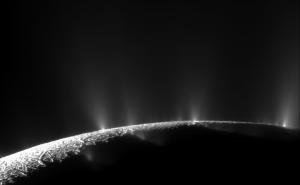The most recent spacecraft telemetry was acquired on May 26 from the Deep Space Network tracking complex at Goldstone, California. The Cassini spacecraft is in an excellent state of health and all subsystems are operating normally.
The most recent spacecraft telemetry was acquired on May 26 from the Deep Space Network tracking complex at Goldstone, California. The Cassini spacecraft is in an excellent state of health and all subsystems are operating normally. Information on the present position and speed of the Cassini spacecraft may be found on the “Present Position” page at: http://saturn.jpl.nasa.gov/mission/presentposition/.
Wednesday, May 20 (DOY 140)
Today the Composite Infrared Spectrometer (CIRS) observed the rings at 20 degrees phase angle. This was part of an ongoing set of measurements to study the vertical thermal distribution within the rings by looking at the lit and unlit sides at similar geometries.
The Magnetometer (MAG) then performed an instrument calibration with the spacecraft rolling for seven hours. The Ultraviolet Imaging Spectrograph (UVIS) concluded observations for the day with an 8-hour Saturn system scan to measure atomic oxygen and hydrogen.
Thursday, May 21 (DOY 141)
Today Cassini encountered Titan at an altitude of 965 kilometers, traveling at a speed of 6.0 km/sec. Closest approach occurred at 03:42 PM PDT, latitude 22 degrees S. RADAR was the prime instrument and directed spacecraft pointing during much of this flyby. The instrument performed observations involving scatterometry, altimetry, and synthetic aperture RADAR (SAR). The SAR observation occurred over the southern hemisphere with the instrument sweeping across the NW Shangri-La dune fields and into high southern latitudes.
The Ion and Neutral Mass Spectrometer (INMS) rode along with RADAR and obtained night side coverage at low southern latitudes. This flyby provided a unique opportunity for INMS, allowing coverage for the outer flank of the magnetospheric interaction region.
On the inbound leg, the phase angle was much larger than 90 degrees. This provided an opportunity for the Visual and Infrared Mapping Spectrometer (VIMS) to ride along and obtain information on Titan’s atmosphere composition. After closest approach, VIMS rode along with CIRS. While CIRS obtained data for composition integrations and stratospheric temperature maps, VIMS observed the south polar region and obtained cloud-monitoring data.
The Ultraviolet Imaging Spectrograph (UVIS) obtained an image cube of Titan’s atmosphere at Extreme Ultraviolet and Far Ultraviolet wavelengths. These cubes provide spectral and spatial information on nitrogen emissions, H emission and absorption, absorption by simple hydrocarbons, and the scattering properties of haze aerosols. This is one of many such cubes gathered over the course of the mission to provide latitude and seasonal coverage of Titan’s middle atmosphere and stratosphere.
The Magnetospheric Imaging Instrument (MIMI) measured energetic ion and electron energy input to Titan¹s atmosphere, and Radio and Plasma Wave Science (RPWS) measured thermal plasmas in Titan’s ionosphere and surrounding environment, searched for lightning in Titan’s atmosphere, and investigated the interaction of Titan with Saturn’s magnetosphere.
Friday, May 22 (DOY 142):
A preview meeting for Titan flybys T55- T61 was held today. Between May 21 and Aug. 25, there will be seven targeted flybys of Titan. This meeting allowed personnel from all instrument teams to share what observations are planned and the significance of the data to be acquired.
T55 through T61 are all inbound to Saturn flybys. All are lit outbound after the flyby and occur at roughly 2200 hours local solar time. The T52-T62 sequence of flybys sets up the correct inclination profile for rings viewing during the equinox period.
Saturday, May 23 (DOY 143):
At the Preliminary Navigation Review for Orbit Trim Maneuver (OTM) #197, the NAV team demonstrated that the downstream cost of canceling the maneuver was about 155 mm/s. Accepting this small cost would reduce the Memorial Day holiday weekend workload for the flight team and save a maneuver cycle on the reaction control subsystem thrusters. As a result, OTM-197, the T55 cleanup maneuver, was canceled.
Science activities today included ring observations involving temperature differences between the lit and unlit sides, and moon shadows on the rings. The Cassini Plasma Spectrometer performed Magnetospheric and Plasma Science (MAPS) surveys, and the Cosmic Dust Analyzer observed as Cassini ascended through the plane of Saturn’s rings.
Monday, May 25 (DOY 145):
Today images were taken of Dione, Prometheus and the rings, and Epimetheus and Janus in support of the 7th edition of the Cassini Scientist for a Day outreach activity. Students from around the country have submitted essays as to why one of these three targets would yield the best science results. Stay tuned for news on the winner next week. For more information on this event link to:
http://saturn.jpl.nasa.gov/education/scientistforaday7thedition/intro/
Tuesday, May 26 (DOY 146)
Spacecraft Operations sent the first commands to the spacecraft today in preparation for the ACS A8.7.7 flight software (FSW) update. The update will be in place from June 2009 to July 2010, and will update the default safing attitude and the default thruster magnitudes. Uplink will continue for the next two days with FSW checkout planned for next week.
The Cassini-Huygens Analysis and Results of the Mission (CHARM) teleconference for May addressed “The effects of the solar wind on Saturn¹s space environment.” A PDF of the presentation can be found at:
http://saturn.jpl.nasa.gov/video/products/MultimediaProductsCharm/
































